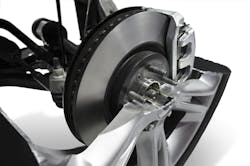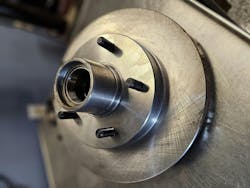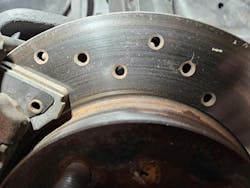Technicians can't go to any sort of training event without being inundated with instruction and information on ADAS.
From blind spot monitoring, lane departure warning, and lane-keep assistance (LKA) to adaptive cruise control (ACC), automatic emergency braking (AEB) and cross traffic alert, all these systems work in concert with one another to keep drivers and their passengers safe. And while all these systems are important for a technician to understand, these ADAS systems only work as well as the base vehicle system they work with. This means lane-keep assistance won’t keep you in the lane if the tie rod ends and ball joints are worn out, or vehicle stability control is unable to correct for a skid as effectively if the wheel speed input it’s getting from one of the corners is not accurate. These systems must work in unison, at the same efficiency as designed by the engineers, to keep us safe during intervention events. At the top of the list for these systems to operate at peak performance is the base brake system.
Brake Rotor Function and Heat Dissipation
When it comes to the brake system, most agree the focus is generally on brake pads. Brake pad material makeup and design, friction coefficient, and even the shape of the puck, are all important factors on how well a brake system will perform, both in terms of stopping efficiency as well as noise. But the often-overlooked partner in the brake system is the brake rotor itself. Rotor design plays as crucial a role in brake system performance as the brake pad, and it's an important relationship for a technician to understand to make sure they’re selecting a rotor that can match the performance of the brake pad and help with the needed outgassing and heat dissipation. The brake rotor’s main function is to convert kinetic energy into heat through friction. As the brake pads are applied to the rotor, that friction generates tremendous amounts of heat, and the rotor material makeup, as well as its ability to dissipate that heat, greatly affects brake system performance.
Rotor design has evolved, just like everything else in the automotive industry. Starting out in the early days of disc brake systems as mainly cast iron units with integrated hubs, they have evolved into a variety of designs using a range of materials to provide heat dissipation. The design also takes into consideration the drive to reduce unsprung weight to improve fuel efficiency and braking performance. But with that weight savings can come the trade-off of reduced durability and increased noise, vibration, and harshness. Cast iron does a wonderful job in heat dissipation but adds significant weight and is prone to corrosion. Carbon ceramic rotors can have longer service lives but are costly. There is a give and take and that balancing act is taken into consideration when the vehicle and braking system are being designed at the factory. It’s something to keep in mind when servicing these systems, especially when servicing a vehicle with vehicle stability control and ADAS technologies.
Cast Iron Rotors: The Standard Choice
As the four-wheel drum brake system transitioned into the early front disc rear drum braking systems around the midpoint of the last century, auto manufacturers still used a relatively similar cast iron metallurgy as many of the previous drum brake designs. Cast iron brake rotors offer many advantages. Cast iron has a high thermal mass meaning it can absorb significant amounts of heat without seeing a degradation of performance, which helps maintain consistent braking performance under more typical driving conditions. Cast iron is also relatively cost effective, especially when compared against materials like the aforementioned carbon ceramics. It’s also readily available for both the OE and the aftermarket. Manufacturing is also well established, which helps keep those production costs down. While cast iron has many advantages, it has limitations as well. Factors like increasing vehicle unsprung weight negatively affect vehicle performance, and economy. Cast iron is also prone to oxidation and rust, though some modern coatings like zinc and ceramic, or high-carbon alloys, can help to improve their corrosion resistance. Cast iron also absorbs heat very well, but even with ventilation it does not dissipate that heat as well as some of the composite options available. It’s the heat buildup under very heavy braking events that can lead to rotor failures like cracking over time. Cast iron gives consistent braking performance that’s crucial for systems like automatic emergency braking and adaptive cruise control, but the added weight and high heat retention can make other designs more desirable in certain applications.
Carbon Ceramic Rotors: High-Performance Solution
On the other end of the spectrum are carbon ceramic brake rotors. These rotors are used in ultra luxury and high-performance/super car applications like the C7 and C8 ZR1 Corvette, McLaren P1, various Porsche models and the Mercedes-AMG GT Black Series. These rotors are constructed from a carbon-fiber reinforced silicon carbide composite. This offers exceptional heat resistance, weight reduction, and longevity compared to traditional cast iron rotors. These rotors can withstand temperatures of over 1,000 degrees Fahrenheit without losing braking effectiveness, but they can shed that heat fairly quickly and that reduction of heat buildup also minimizes brake fade helping to ensure consistent stopping power. While light braking before the brakes have a chance to warm up can be less effective compared to cast iron rotors, the main downside to carbon ceramic is the cost. These rotors can often cost thousands of dollars per set, which really limits their widespread adaptation beyond the ultra-high end.
Composite Rotors: A Middle Ground
With both ends of the spectrum covered between the jack-of-all-trades cast iron on one end and the ultra-premium carbon ceramic on the other, engineers have sought to find some middle ground. Composite rotors give us that flexibility. Composite or hybrid brake rotors combine different materials, like cast iron and aluminum, to optimize weight, heat dissipation, durability, and cost. These designs improve braking efficiency, reduce unsprung weight, and enhance overall vehicle handling. Some of the key benefits of composite rotors are they reduce weight without sacrificing strength. They do this using a two-piece design, running a lightweight material on the hat like aluminum — this reduces overall weight compared to full cast iron rotors. This less unsprung weight improves handling, acceleration, fuel efficiency, and even has a positive impact by reducing strain on suspension components, improving vehicle dynamics. The aluminum center also helps disperse heat more efficiently, and floating or semi-floating designs allow for thermal expansion, which minimizes stress cracking. ADAS features like AEB and ACC require predictable and fade-resistant braking performance, and composite rotors ensure that consistent braking force, which improves the accuracy of ADAS-controlled stops. While composite brake rotors are significantly cheaper than options like carbon ceramic, they still are generally a higher price point than a traditional cast iron option. Also, some of the lesser expensive aftermarket composite rotor designs have been prone to suffering from hat-to-ring separation under extreme conditions.
Cooling Strategies
There is far more to rotor design than the material from which they are manufactured. Many of their performance characteristics come from their design features as well, with the goal of converting that kinetic energy to heat through friction. And to dissipate that heat, we need airflow. The primary way this is accomplished is through internal cooling vanes or channels between the two braking surfaces. It’s the goal of these vanes to simply increase the airflow to improve heat dissipation and reduce fade. These vanes work well, as long as they can stay clear enough to perform their intended function. In heavy rust-prone areas, there is a tendency for rust and road debris to clog those vanes, prohibiting needed airflow and throwing the brake rotor off balance. Some manufacturers have moved away from the traditional vane design and have incorporated pillars and other designs to improve airflow further and lessen the chances of some of these clogging events. Also, though becoming more rare, some lighter vehicle applications still use a solid rotor, especially in the rear. Solid rotor designs can provide a lightweight option where weight savings are crucial, and they are more resistant to debris. Since they are less likely to trap dirt, they are ideal for offroad applications.
Managing Outgassing
When it comes to braking performance, heat dissipation is a necessity, and metallurgy and design play critical roles in high performing and consistent braking. However, there are other forces at work that need consideration for optimal performance. We have established that heat is a trade off of the braking process, and the more aggressively the brakes are applied, the higher the heat that is generated. During heavy braking, brake pads release gas as they heat up in a process called “outgassing.” The amount of gas varies by pad makeup, but the result is a thin layer of gas that acts as a buffer between the pad and the rotor. This can dramatically affect how much contact the brake pads make with the rotor, and thus affect the ability of the brakes to slow the vehicle.
Under normal daily driving conditions, outgassing does not occur at a rate that drastically impedes braking function. But in applications where continuous high heat levels are expected, there comes the need to allow that built up layer of gas to escape from between the pad and rotor. To facilitate this, rotor manufacturers have implemented technologies like slotting and cross drilling to allow the gas layer to dissipate. While a cross drilled rotor allows for the removal of gas buildup and additional cooling due to more airflow, this comes at a cost — the structural integrity of the rotor. Cross drilled rotors are susceptible to cracking between drill points after prolonged heavy use. Slotted rotors are stronger structurally than a cross drilled design because of the fewer stress points, but they can accelerate brake wear as the slot edges can act like a file, wearing pads quicker than a smooth or drilled rotor design.
Corrosion Resistance: Coating Technologies
The lion’s share of brake rotors in use today on passenger vehicles are still the tried-and-true cast iron design, and as we stated earlier, one of the largest drawbacks to these rotors is oxidation and corrosion. Corrosion not only adversely affects braking performance and rotor life, but it also negatively affects the vehicle’s aesthetics. The trend in modern vehicle design is to have a larger, more open wheel, and a rusty brake rotor takes away from that look.
It’s for these reasons that many brake rotor manufacturers have started providing corrosion-resistant coatings for their rotors to keep them corrosion-free longer in even some of the harshest environments. Manufacturers use a variety of coating materials to accomplish this goal, depending on rotor makeup and overall price point. One of the more common coatings used is a zinc coating. Zinc coating is applied to a brake rotor via electroplating, or dipping, and it forms a barrier against moisture and road salt. Zinc provides sacrificial protection, meaning it will corrode before the iron does. Zinc is cost effective and widely used, helping to protect against premature wear and compromised structural integrity. The drawback: it’s a relatively thin layer of protection, and because of its sacrificial properties, it tends to disappear quickly in extreme conditions.
Ceramic coating is another option used by rotor manufacturers to protect the brake rotor. Like zinc, ceramic coatings are resistant to rust and corrosion, but unlike zinc, ceramic is more resistant to extreme heat, making it well suited for performance and premium applications. The tradeoff with ceramic coatings is it’s significantly more expensive than zinc, and it is more labor intensive to apply to ensure even coating and protection.
Phosphate coating, or what is also known and “e-coating” is a chemical coating where the iron rotor is submerged in a phosphate-based solution, then a liquid paint solution is applied and electrically charged — causing the coating particles to bond evenly to the metal surface. This, paired with a curing process, ensures durability and longevity of the coating on the non-friction surfaces. Common with many OE and aftermarket replacement rotors, e-coating provides a more durable barrier than zinc but at a more competitive price point than ceramic coating. The submerging and electrophoretic deposition allows for precise control and even coating on not just the rotor hat and outer surfaces, but also the inner structure of the rotor and vanes helping ensure a longer life in even the most corrosive parts of the Rust Belt.
Rotor Metallurgy: Grey Cast Iron Versus High Carbon Rotors
When it’s time to select a replacement brake package for a customer vehicle, all the tradeoffs listed throughout this article need to be taken into consideration. Aftermarket availability of not only brake pads but also brake rotors varies significantly in terms of design and quality, even across a single vehicle model. Rotor metallurgy is an important part of that. For automotive use, cast iron brake rotors, in terms of metallurgy, are generally broken down into two broad categories: grey cast iron rotors and high carbon cast iron rotors.
Grey cast iron typically has a lower carbon content. Carbon plays a crucial role in brake rotor design by improving thermal stability, wear resistance, vibration damping, and overall durability. Grey cast iron often comes with carbon content between 2.5% and 3% and can be more susceptible to thermal expansion under heavy load, and can be more prone to noise and vibration.
High carbon rotors not only have a higher carbon content (3.2% to 3.6%) but also include a higher concentration of flake graphite and additional alloying elements, such as molybdenum, nickel, or copper. These additional elements — along with the higher carbon content and finer, more uniform graphite distribution — provide higher tensile strength, additional thermal management properties, and better vibration mitigation than a standard grey cast iron.
It’s important to understand the makeup of the rotor that came on the vehicle from the factory, and match with a similar replacement especially when working on a vehicle equipped with AEB and other ADAS considerations.
Selecting the Right Brake Rotor
Understanding the complex interplay between a vehicle's braking system and its ADAS is crucial for technicians. The base brake components, particularly the brake rotor, play an essential role in maintaining system performance. Whether it’s the familiar cast iron rotors, the high-performance carbon ceramic options, or the versatile composite designs, each material and design choice has its strengths and trade offs. As ADAS technologies continue to evolve, selecting correct brake system components, with attention to rotor design and performance characteristics, ensures that these safety systems can operate efficiently. Ultimately, a well-matched brake system contributes to both the safety and reliability of modern vehicles.
About the Author
Erik Screeden
Technical and Multimedia Content Director
Erik Screeden is the Technical and Multimedia Content Director for the Vehicle Service & Repair Group. Erik is an ASE Master Automobile Technician with L1, and L4 credentials, who has been in the industry for over 25 years in various capacities. During that time, Screeden was a technician. He started out at a Ford dealership and continued to several independent repair facilities as well as spent time in the specialty aftermarket at a GM-specific performance shop. After his time as a technician came to an end, Screeden transitioned into a role providing scan diagnostic and J2534 tool support. He was then able to parlay his experience as a technician and a support specialist and use that in several technical sales roles.
Don't miss any of Screeden's video content sign up for Autoplay.



